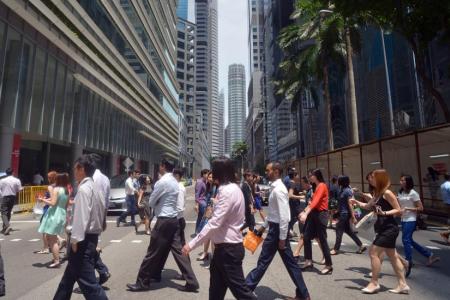Fewer job vacancies amid slowdown as employers become cautious
Ministry of Manpower report shows hiring sentiments becoming cautious, unemployment rates rise
There was no spike in layoffs despite the economic slowdown but job seekers faced a tougher slog in the first half of this year.
The number of job openings declined amid uncertainties, and the citizen and resident unemployment rates inched up, according to the latest labour market data released by the Ministry of Manpower (MOM) yesterday for the second quarter of the year.
"Final data confirmed that employers are retaining their existing workers despite economic headwinds... At the same time, hiring sentiments have turned cautious," said the ministry in its report.
The number of job vacancies declined for the second consecutive quarter to 47,700 in June, down from 57,100 in March, after accounting for seasonal variations. This meant for the first time in more than a year, there were fewer job vacancies than unemployed people.
In June, there were 94 vacancies for every 100 workers who were unemployed.
The softer job market made it harder for residents to find a job within six months of being laid off.
This re-entry rate fell to 60 per cent in the second quarter of this year, the lowest rate in at least four years.
The seasonally adjusted unemployment rate for Singaporeans climbed for the third consecutive quarter to 3.3 per cent in June, up from 3.2 per cent in March.
For residents - Singaporeans and permanent residents combined - the rate was 3.1 per cent in June, up from 3 per cent in March, while the overall rate was stable at 2.2 per cent in June.
The June unemployment figures are preliminary.
Retrenchments fell to 2,320 in the second quarter, down from 3,230 in the first quarter.
Professionals, managers, executives and technicians continued to make up the lion's share of locals who were laid off, at 77 per cent.
Companies appear to have been turning more to temporary arrangements to manage labour costs, instead of letting staff go.
In the past three quarters, more employees were placed on short workweek or temporary layoff arrangements, though levels were much lower than during recessionary periods, said MOM in a technical note in its report.
SHORTER
A shorter workweek is where employees work fewer hours a day or fewer working days a week, while a temporary layoff is where an employee is asked to stop going to work for a short period due to lack of work.
During downturn periods, the majority of those on these arrangements were from manufacturing and tended to be production and related workers, noted MOM.
Recruitment company ManpowerGroup Singapore country head Linda Teo said the arrangements allow employers to retain their experienced talent and avoid additional recruitment costs when business recovers.
"Employers should allow employees who are temporarily laid off or working shorter weeks the flexibility to find other employment to supplement their incomes," she said.
Observers said they expect the labour market to continue softening but at a gradual pace.
Said OCBC Bank head of treasury research and strategy Selena Ling: "Employers are waiting to see whether the external macro headwinds are going to pass with time. They may worry that if they fire people now, they may have more difficulty hiring people again."
FOR MORE, READ THE STRAITS TIMES TODAY
Get The New Paper on your phone with the free TNP app. Download from the Apple App Store or Google Play Store now


